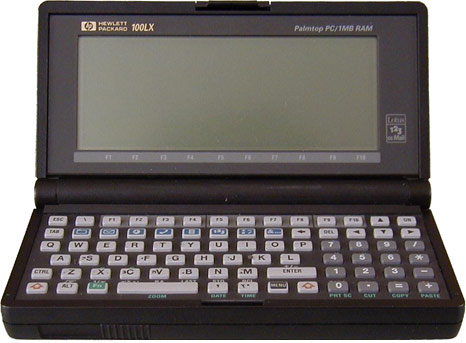DOS Palmtop: HP 100LX Details and specs
Hewlett Packard 100 LX (HP 100LX)

About this machine:
The HP 100LX was the second machine Hewlett packard produced in its series of DOS-based palmtop computers. Development codename: HP Cougar.
Like its predecessor - the 95LX - it is a miracle regarding size and handling. The LX100 fixes the worst flaw of the 95LX - the graphics.
The 100LX finally comes with fully monochrome CGA compliant graphics adaptor and display and thus opens up a whole world of CGA based applications.
While this seems to bring the HP palmtop models just "on par" with the earlier "poqet PC" competitor it actually finally got HP on the top as
a manufacturer of palmtop PCs. The difference was not just that the HP 100LX was significantly smaller than the competitors palmtops - it also
included some important features others lacked. Not just big changes like the introduction of the PCMCIA 2.0 Type 2 slot which enabled users to
pick from a variety of PCMCIA addons like flash cards and modems but also some smaller differences which are based on the software and finally result in
the legendary "handling" which i always underline for these devices. On the one side you have the boot options which allow you to boot from the
PCMCIA slot, so you could use alternative Operating Systems from a Flash or Compact Flash card (With a PCMCIA Adaptor). While for the novice this
may not sound too impressive it is vital at getting some applications to run - other palmtops clog memory with their drivers and PIM software while
100LX users can do a "clean" boot from a Flash card. But even if you "screw up" your system you can always recover it from ROM - not like for example
the Fujitsu Oasys pocket which leaves you quite helpless in case you try to format the system drive. Other small differences are the exceptionally
well-made PIM GUI or for example the simple keyboard shortcut "/" and "On" which lets you invert the monochromatic CGA display. This may also sound
unspectacular to novice users but if you ever played "Zak McKracken" or "The Secret of Monkey Island" in inverted CGA monochrome Graphics you will
appreciate this feature a lot. Also doing a hard reset ("CTRL" + "SHIFT" + "ON") via a keyboard shortcut is quite more handy than using a pen to push
some hidden reset button or removing the batteries. Another useful function is the "zoom" mode which offers 2x and 4x zoom.Surprisingly the
successor 200LX did not offer another quantum-leap of innovation and only came with updated software on the ROM. With nearly 8 MHz the 100LX is around 66% faster
than the 95LX. What is amazing about the 100LX is that although it is significantly faster than the 95LX the battery lasts even much longer - I would
estimate that batteries last around 3 times longer than in the 95 LX.
Specs:
CPU: Intel 80186 @ 7.91 MHz
Graphics: Monochrome CGA, 80 x 25 character text mode, CGA 2 color monochrome graphics mode
Display: 640 x 200 monochrome STN , 4 grey scales, 4.8 inch
Memory (RAM): 1 MB or 2 MB (1 MB at initial release, 2MB model as second production run in February 1994)
ROM (Software): 2 MB
I/O ports: RS232 Serial (proprietary 10 pin cable was optional accessory), PCMCIA 2.0 Type 2 slot, Infrared (SIR, NOT IrDA)
Sound: PC Speaker - Piezo
Operating System: MS-DOS 5.0
Software: Lotus 1-2-3, basic word processing, phone book, calculator, file manager, database, CC:Mail and much more
Size: Length 8.5cm, Width 15.9cm, Height 2.6cm (3.4 inches x 6.3 inches x 1 inch)
Powered by: 2 AA batteries - rechargable or non-rechargable or AC adaptor (optional accessory), CR2032 Lithium button cell as memory backup
Weight: 340 gram (12 ounces) including 2 standard AA and CR2032 batteries
Special features: Key-Combination to invert display, SIR infrared (HP JetEye Infrared printer port compatible). RAM can be configured as additional RAMDISK space for saving user files.
Released: April 1993
Originally retailed for:: 749 USD
Clone of: Not a clone. Successor model of HP 95LX
Similar models: HP 95LX, 100LX, 1000CX, Omnigo 700LX
Pros:
- Quite easily available, usually not as expensive as the 200LX
- Excellent for easy printing on JetEye compatible HP printers
- Contains Lotus 1-2-3 spreadsheet, database, CC:Mail and word processor
- Outstanding battery life
- PCMCIA 2.0 Type 2 slot: Can use flash cards or compact flash (With PCMCIA Adapter)
- Fully CGA compliant, so most CGA based DOS appz and games work
Cons:
- Keyboard extremely small, not comfortable for really typing a lot
- Infrared not fully IrDA compatible
- Not as cheap as the HP 95LX model
Collector Value:
3 of 10
Usage Value:
8 of 10
Verdict:
Give it a usability value of 10/10 if you love the tiny keyboard. Along with the 200LX and successors this is THE most
useful palmtop if you can cope with the small keyboard. The only flaws might be the proprietary 10 PIN Serial cable that
was unfortunately an optional accessory (But luckily produced in large quantities and thus still available rather often)
and the missing parallel port. But still the 100LX along with its successors is one of the most handy DOS-based palmtops
as of 2011. As most people want a 200LX (Which only offers slightly updated software on the ROM) this is affordable and
probably a tad more rare than the 200LX. Battery life is probably among the best you ever witnessed for any palmtop.
Back to the Palmtop PC index
